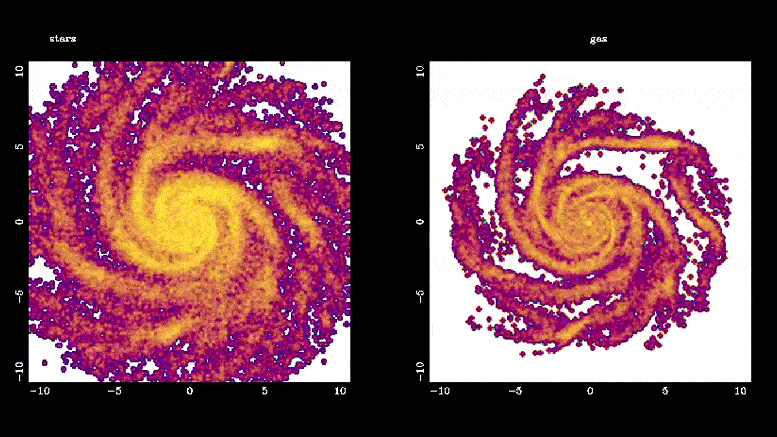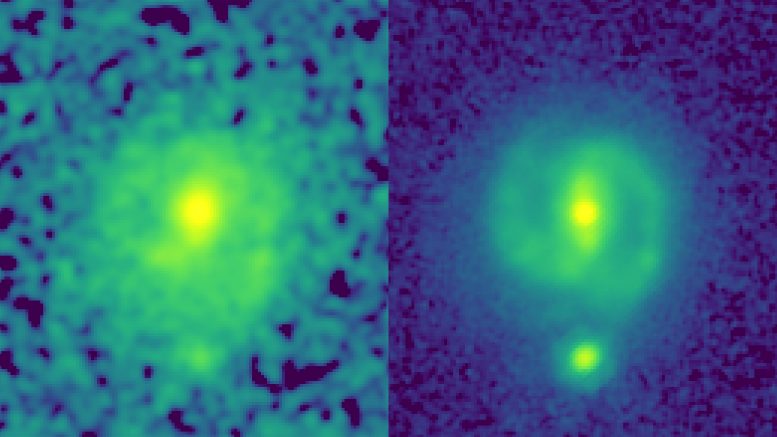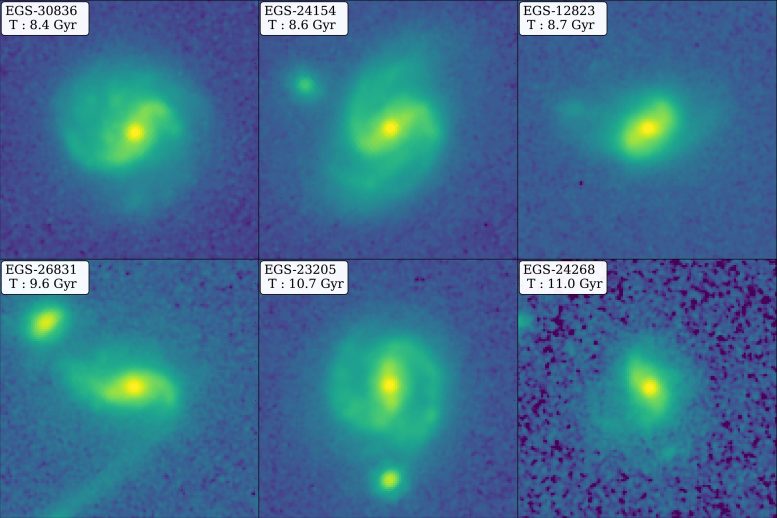
This simulation shows both how stellar bars form (left) and the bar-driven gas inflows (right). Stellar bars play an important role in galaxy evolution by funneling gas into the central regions of a galaxy, where it is rapidly converted into new stars, at a rate typically 10 to 100 times as fast as the rate in the rest of the galaxy. Bars also indirectly help to grow supermassive black holes in the centers of galaxies by channeling the gas part of the way. Credit: Francoise Combes, Paris Observatory
New images from NASA’s James Webb Space Telescope (JWST) reveal for the first time galaxies with stellar bars — elongated features of stars stretching from the centers of galaxies into their outer disks — at a time when the universe was a mere 25% of its present age. The finding of so-called barred galaxies, similar to our Milky Way, this early in the universe will require astrophysicists to refine their theories of galaxy evolution.
Prior to JWST, images from the Hubble Space Telescope had never detected bars at such young epochs. In a Hubble image, one galaxy, EGS-23205, is little more than a disk-shaped smudge, but in the corresponding JWST image taken this past summer, it’s a beautiful spiral galaxy with a clear stellar bar.
“I took one look at these data, and I said, ‘We are dropping everything else!’” said Shardha Jogee, professor of astronomy at The University of Texas at Austin. “The bars hardly visible in Hubble data just popped out in the JWST image, showing the tremendous power of JWST to see the underlying structure in galaxies,” she said, describing data from the Cosmic Evolution Early Release Science Survey (CEERS), led by UT Austin professor, Steven Finkelstein.

The power of JWST to map galaxies at high resolution and at longer infrared wavelengths than Hubble allows it look through dust and unveil the underlying structure and mass of distant galaxies. This can be seen in these two images of the galaxy EGS23205, seen as it was about 11 billion years ago. In the HST image (left, taken in the near-infrared filter), the galaxy is little more than a disk-shaped smudge obscured by dust and impacted by the glare of young stars, but in the corresponding JWST mid-infrared image (taken this past summer), it’s a beautiful spiral galaxy with a clear stellar bar. Credit: NASA/CEERS/University of Texas at Austin
The team identified another barred galaxy, EGS-24268, also from about 11 billion years ago, which makes two barred galaxies existing farther back in time than any previously discovered.
In an article accepted for publication in The Astrophysical Journal Letters, they highlight these two galaxies and show examples of four other barred galaxies from more than 8 billion years ago.
“For this study, we are looking at a new regime where no one had used this kind of data or done this kind of quantitative analysis before,” said Yuchen “Kay” Guo, a graduate student who led the analysis, “so everything is new. It’s like going into a forest that nobody has ever gone into.”
Bars play an important role in galaxy evolution by funneling gas into the central regions, boosting star formation.
“Bars solve the supply chain problem in galaxies,” Jogee said. “Just like we need to bring raw material from the harbor to inland factories that make new products, a bar powerfully transports gas into the central region where the gas is rapidly converted into new stars at a rate typically 10 to 100 times faster than in the rest of the galaxy.”
Bars also help to grow supermassive black holes in the centers of galaxies by channeling the gas part of the way.
This simulation shows both how stellar bars form (left) and the bar-driven gas inflows (right). Stellar bars play an important role in galaxy evolution by funneling gas into the central regions of a galaxy, where it is rapidly converted into new stars, at a rate typically 10 to 100 times as fast as the rate in the rest of the galaxy. Bars also indirectly help to grow supermassive black holes in the centers of galaxies by channeling the gas part of the way. Credit: Francoise Combes, Paris Observatory
The discovery of bars during such early epochs shakes up galaxy evolution scenarios in several ways.
“This discovery of early bars means galaxy evolution models now have a new pathway via bars to accelerate the production of new stars at early epochs,” Jogee said.
And the very existence of these early bars challenges theoretical models as they need to get the galaxy physics right in order to predict the correct abundance of bars. The team will be testing different models in their next papers.

Montage of JWST images showing six example barred galaxies, two of which represent the highest lookback times quantitatively identified and characterized to date. The labels in the top left of each figure show the lookback time of each galaxy, ranging from 8.4 to 11 billion years ago (Gyr), when the universe was a mere 40% to 20% of its present age. Credit: NASA/CEERS/University of Texas at Austin
JWST can unveil structures in distant galaxies better than Hubble for two reasons: First, its larger mirror gives it more light-gathering ability, allowing it to see farther and with higher resolution. Second, it can see through dust better as it observes at longer infrared wavelengths than Hubble.
Undergraduate students Eden Wise and Zilei Chen played a key role in the research by visually reviewing hundreds of galaxies, searching for those that appeared to have bars, which helped narrow the list to a few dozen for the other researchers to analyze with a more intensive mathematical approach.
Reference: “First Look at z > 1 Bars in the Rest-Frame Near-Infrared with JWST Early CEERS Imaging” by Yuchen Guo, Shardha Jogee, Steven L. Finkelstein, Zilei Chen, Eden Wise, Micaela B. Bagley, Guillermo Barro, Stijn Wuyts, Dale D. Kocevski, Jeyhan S. Kartaltepe, Elizabeth J. McGrath, Henry C. Ferguson, Bahram Mobasher, Mauro Giavalisco, Ray A. Lucas, Jorge A. Zavala, Jennifer M. Lotz, Norman A. Grogin, Marc Huertas-Company, Jesús Vega-Ferrero, Nimish P. Hathi, Pablo Arrabal Haro, Mark Dickinson, Anton M. Koekemoer, Casey Papovich, Nor Pirzkal, L. Y. Aaron Yung, Bren E. Backhaus, Eric F. Bell, Antonello Calabrò, Nikko J. Cleri, Rosemary T. Coogan, M. C. Cooper, Luca Costantin, Darren Croton, Kelcey Davis, Alexander de la Vega, Avishai Dekel, Maximilien Franco, Jonathan P. Gardner, Benne W. Holwerda, Taylor A. Hutchison, Viraj Pandya, Pablo G. Pérez-González, Swara Ravindranath, Caitlin Rose, Jonathan R. Trump and Weichen Wang, Accepted, The Astrophysical Journal Letters.
arXiv:2210.08658
Other co-authors from UT Austin are Steven Finkelstein, Micaela Bagley and Maximilien Franco. Dozens of co-authors from other institutions hail from the U.S., the U.K., Japan, Spain, France, Italy, Australia and Israel.
Funding for this research was provided in part by the Roland K. Blumberg Endowment in Astronomy, the Heising-Simons Foundation, and NASA. This work relied on resources at the Texas Advanced Computing Center, including Frontera, the most powerful supercomputer at a U.S. university.
https://news.google.com/__i/rss/rd/articles/CBMieGh0dHBzOi8vc2NpdGVjaGRhaWx5LmNvbS9qYW1lcy13ZWJiLXNwYWNlLXRlbGVzY29wZS1sb29rcy1iYWNrLWludG8tdGhlLWVhcmx5LXVuaXZlcnNlLXNlZXMtZ2FsYXhpZXMtbGlrZS1vdXItbWlsa3ktd2F5L9IBAA?oc=5
2023-01-08 22:20:34Z
1728997799
Tidak ada komentar:
Posting Komentar